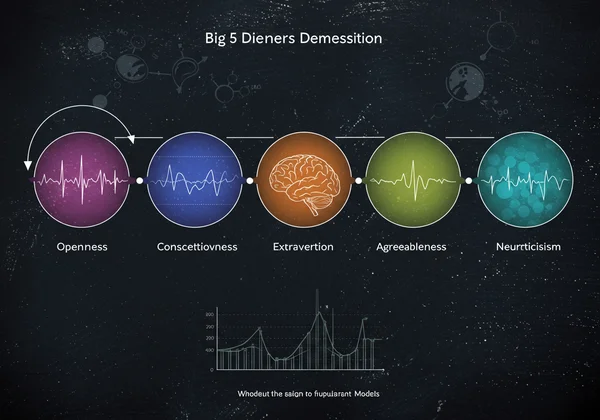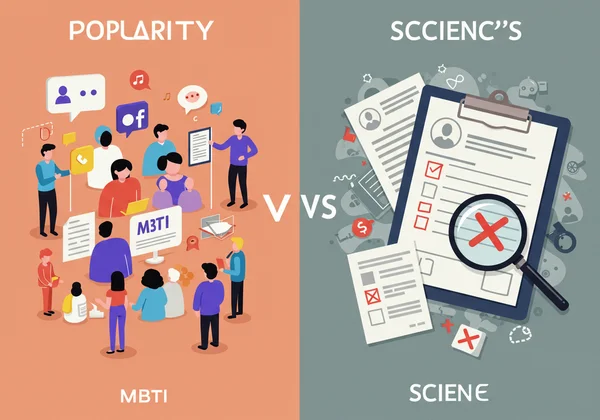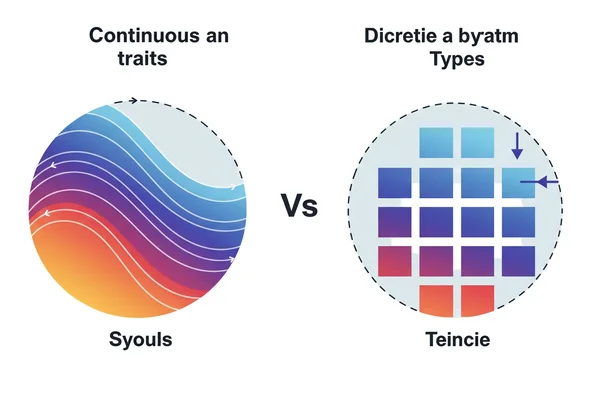5大性格测试与MBTI:哪个更具科学性?
您是否曾在网上进行过性格测试?如果是,您可能已经接触过迈尔斯-布里格斯类型指标(MBTI)和 5大性格测试。两者都承诺能让您更深入地了解自己,但作为一名心理学爱好者,我经常被问到:迈尔斯-布里格斯与5大性格模型有什么区别? 而更关键的是,在科学准确性和提供真正具有价值的洞察方面,其中一个评估工具高下立判。
本指南将深入探讨这两种模型背后的科学原理。我们将深入探讨它们的基础,比较它们的方法,并帮助您理解为何心理学家们普遍更青睐其中一种。如果您准备好踏上一段由研究支持的真正自我发现之旅,让我们开始吧。您可以先探索一个 科学性格测试,了解其原理。
5大性格测试:科学基础
5大性格模型,也常被称为“五因素模型”(FFM),是学术心理学界最受尊敬和广泛接受的性格结构模型。它并非由某一个人创造,而是源于多位独立科学家数十年的研究成果。他们分析了用于描述人的语言,发现大多数性格特征都可以归结为五个广泛的维度。
这个模型并非将您塞进一个整洁的“盒子”。相反,它在五个核心特质的每个维度上衡量您的性格。这种细致入微的方法能更真实、更全面地描绘您独特的心理构成。

理解OCEAN特质
5大性格模型很容易通过首字母缩略词OCEAN(或CANOE)来记忆。每个字母代表一个核心性格维度,每个人在每个特质上都处于某个区间。
- 经验开放性(Openness to Experience):这个特质反映了您的想象力、创造力和求知欲。得分高的人喜欢冒险,享受新事物;得分低的人则偏爱常规和熟悉的事物。
- 尽责性(Conscientiousness):这衡量了您的组织能力、自律性和目标导向行为。得分高的人可靠且勤奋;得分低的人则更随性,结构性较差。
- 外向性(Extraversion):这一维度与您的社交性、果断性和情感表达有关。得分高的人外向,从社交互动中获得能量;得分低的人(内向者)则更内敛,从独处中获得能量。
- 宜人性(Agreeableness):这反映了您富有同情心、合作和信任他人的倾向。得分高的人通常温暖而乐于助人;得分低的人则更具竞争性和怀疑性。
- 情绪不稳定性(Neuroticism):这个特质衡量了您的情绪稳定性以及体验焦虑、悲伤和愤怒等负面情绪的倾向。得分高的人情绪反应更强烈;得分低的人则普遍平静而有韧性。
为何5大性格模型备受心理学家青睐
那么,心理学家使用的是哪种性格测试呢?答案压倒性地指向5大性格模型。它的优势在于其经验基础。该模型已经在众多文化和人群中得到检验和验证,显示出非凡的可靠性。数十年的研究表明,5大性格特质在成年后相对稳定,并且是现实世界结果的有力预测因子。
例如,尽责性是学术成功和工作表现的有力预测指标。外向性与领导角色相关联,而情绪不稳定性则与心理健康结果相关。这种预测能力使其成为个人成长、职业咨询和学术研究中宝贵的 性格评估工具。当您需要可据以行动的见解时,5大性格模型提供了一个扎实、科学的框架。
迈尔斯-布里格斯类型指标(MBTI):流行度与证据的权衡
MBTI可以说是世界上最著名的性格测试。您可能在社交媒体上看到过其四字母代码(如INTJ或ESFP),或者在企业团队建设活动中使用过它。它因其简洁性和对16种类型提供的积极、肯定的描述而广受欢迎。

然而,它在流行文化和商业中的受欢迎程度并不反映其在科学界的地位。虽然它可以作为有趣的谈资,但仔细观察会发现其存在明显的局限性,使其不适合进行严肃的自我评估或职业发展。
MBTI的起源与类型学方法
MBTI由Isabel Myers和Katharine Briggs在第二次世界大战期间开发,其理论基础是她们对卡尔·荣格心理类型理论的解读。需要注意的是,Myers和Briggs都不是受过正式心理学训练的人。她们的目标是让荣格复杂的思想变得易于理解和实用。
该测试根据四个二分法将个体归入16种不同的性格“类型”:
- 内向(I)对外向(E):您如何引导能量。
- 感觉(S)对直觉(N):您如何感知信息。
- 思考(T)对情感(F):您如何做出决定。
- 判断(J)对知觉(P):您如何偏好在外部生活。
这种类型学,或“非黑即白”的方法,是其科学性不足的主要原因。
科学界对MBTI局限性的共识
当我们审视 MBTI accuracy 时,会发现它未能达到心理学工具的标准。大多数现代心理学家不使用MBTI,因为它存在几个关键缺陷。
首先,其重测信度较低,表现为测试结果不稳定。研究表明,高达 50% 的受试者在间隔几周后再次进行测试时会得到不同的类型。一个可靠的测试应该产生一致的结果。其次,该模型将人们强行划分到非此即彼的二元划分中。例如,您要么是“外向者”,要么是“内向者”,没有中间地带。实际上,大多数人介于两者之间,这种差异性是5大性格模型所能精准捕捉的,而MBTI却完全忽视了。
最后,MBTI的预测效度很弱。几乎没有证据表明了解您的MBTI类型有助于预测您的工作满意度、工作表现或人际关系成功。它的类别过于宽泛和僵化,无法提供真正成长所需的个性化、可操作的见解。
主要区别:效度与信度:为何它们是关键
关于 5大性格模型与MBTI 的争论,归根结底在于科学严谨性。当您寻求了解自我时,您应该拥有一个既可靠(一致)又有效(测量其声称测量的东西)的工具。这是区分两者科学严谨性的根本所在。
特质与类型:根本性的方法论分歧
最显著的区别在于“特质与类型”的方法。5大性格模型是基于特质的模型,意味着它将性格视为连续维度的组合。您不仅仅是“外向者”;您具有一定程度的外向性。这使得性格存在无限变化,并能更准确地描述个体。

MBTI是一种基于类型的模型,它将人归入离散的类别。这种过度简化损失了海量信息。两个被归类为“INTJ”的人可能差异很大,但MBTI将他们归为一类,忽略了他们性格特质中微妙但至关重要的差异。如果您正在寻找真正个性化的分析,一个 免费的 5大性格测试 要优越得多。
结果的一致性与稳定性
想象一下,第一天您站上体重秤,它显示 150 磅,第二天却显示 190。您会很自然地认为体重秤坏了。这就是MBTI的信度问题。它的结果往往随时间不稳定,使得人们很难信任其提供的见解。
相比之下,five factor model test 显示出高信度。虽然您的性格可能会发展演变,但5大性格特质在成年后却相当稳定。您今天获得的结果很可能与几年后获得的结果非常相似,为个人发展提供了可靠的基础。准备好 发现您的结果 了吗?
对现实世界结果的预测能力
如果性格测试能帮助您做出更好的决策,那么它就是最有用的。5大性格模型在这方面表现出色。您在OCEAN特质上的得分可以为您的职业道路、人际关系动态和潜在的成长领域提供宝贵的线索。这就是它成为现代心理学研究基石的原因。
MBTI缺乏这种预测能力,更像是一种描述性工具。它可能会给您一个感觉正确的标签,但对于如何利用这些信息来改善您的生活,它提供的指导却很少。为了获得可操作的见解,5大性格模型的科学支持是必不可少的。
选择您通往更深层自我理解的道路
虽然MBTI可以是一种有趣的、简单的开始思考性格的方式,但它缺乏成为真正可靠指南的科学基础。对于那些真正对自我探索、学术研究或职业发展感兴趣的人来说,5大性格测试是明确的选择。它提供了一个细致、稳定且具有预测性的框架,受到全球专家的信赖。

不要满足于有趣的标签,而应追求可操作的科学见解。了解您的OCEAN特质可以解锁更高层次的自我意识,帮助您规划职业生涯、改善人际关系并建立更充实的生活。今天就迈出通往更真实自我认知的步伐吧。
为什么不 参加我们的免费测试,发现您独特的性格档案?立即获得您的核心分数,并可选择解锁人工智能驱动的报告,以获得更深入的个性化见解来指导您的旅程。
关于性格测试有效性的常见问题解答
什么是5大性格测试,为什么它被认为是科学的?
5大性格模型基于五个核心维度:经验开放性、尽责性、外向性、宜人性以及情绪不稳定性(OCEAN)。它之所以被认为是科学的,是因为它基于数十年的实证研究,已在不同的文化中得到验证,并显示出对现实世界结果的高信度和预测效度。
与MBTI相比,5大性格测试的准确性如何?
5大性格模型的准确性要高得多。它具有较高的重测信度(结果一致)和已证实的效度(它测量了它声称测量的东西)。MBTI存在信度低的问题,许多人在多次测试后会得到不同的结果,而且其类型学结构并未得到现代心理学研究的支持。
5大性格测试是否适合个人和职业发展?
当然。5大性格模型对这两方面都是一个极好的工具。它能帮助个人了解自己的优势和劣势,确定适合的职业道路,改善人际关系,并设定有意义的个人成长目标。其预测能力使得这些见解非常实用且可操作。
哪里可以进行免费且可靠的5大性格测试?
您可以在此处进行经过科学验证的 免费 5大性格测试。我们的平台基于五因素模型提供全面的 120 道题评估。完成测试后,您将立即收到您的核心分数,并可以选择访问一份详细的、由人工智能驱动的报告,以获得更深入的个性化见解来指导您的旅程。立即 探索您的特质。